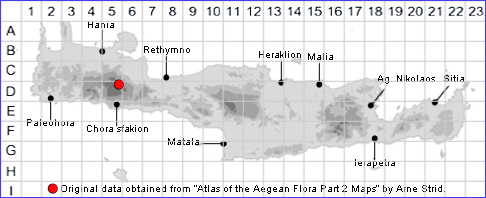
SPECIES DESCRIPTION
NEPETA SPHACIOTICA
Family and Genus:- See- LABIATAE/Sect. PYCNONEPETA
Common Names:- None
Homotypic Synonyms:- None
Meaning:- Nepeta (L) A name used by the Roman naturalist and philosopher Pliny
for plants from Nepi, Etruria, Italy.
Sphaciotica (Gr) Damaged-looking, of gangrened appearance.
General description:- Shortly rhizomatous perennial.
Stems:-
1) 12-18 cm, suberect, sparingly branched, grey-tomentose to villous and glandular-
puberulent with short, patent to deflexed hairs, often viscid.
Leaves:-
1) Short-petiolate or subsessile, green, broad, with few, coarse crenations.
2) Cauline, distinctly petiolate.
3) Blade, 15-25 mm, ovate, cordate to truncate at the base, rugose, crenate, grey-
tomentose on both sides.
Flower:-
1) Inflorescence, very short spike-like.
2) Bracteoles, 5-10 x 0·5-1·5 mm, lanceolate, with distinct scarious margins.
a) outermost, ± equalling the calyx, lanceolate, shortly acuminate, with narrow,
distinct scarious margins.
3) Verticillasters, 6-12-flowered, confluent to a spike-like inflorescence, or the lower
1-2 remote.
4) Calyx, 5.5-7 mm, straight;
a) teeth, equal, 2/3 as long as the tube.
5) Corolla, 9-11 mm, white with small purple dots; lower lip ± bearded.
Fruit:-
1) Nutlets, tuberculate.
Key features:-
1) Stem, 5-15 cm tall, villous and glandular-puberulent.
2) Leaves, short-petiolate or subsessile, coarsely crenate, green.
3) Venicillasters, 6-12-flowered, confluent to a spike-like inflorescence, or the lower
1-2 remote.
Habitat:- Calcareous screes on an open mountain slope 2200-2300 m
Distribution:- A rare and threatend local endemic known only from a small
population on Mt Zvourichti, Lefka Ori, West Crete.
Flowering time:- July-Aug
Photos by:- Christopher Cheiladakis
Status:-
Conservation status (for threatened species): Rare (R) according to IUCN 1997
Protection status (for threatened species): Greek Presidential Decree 67/1981

